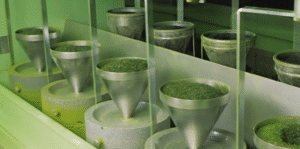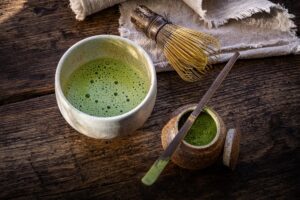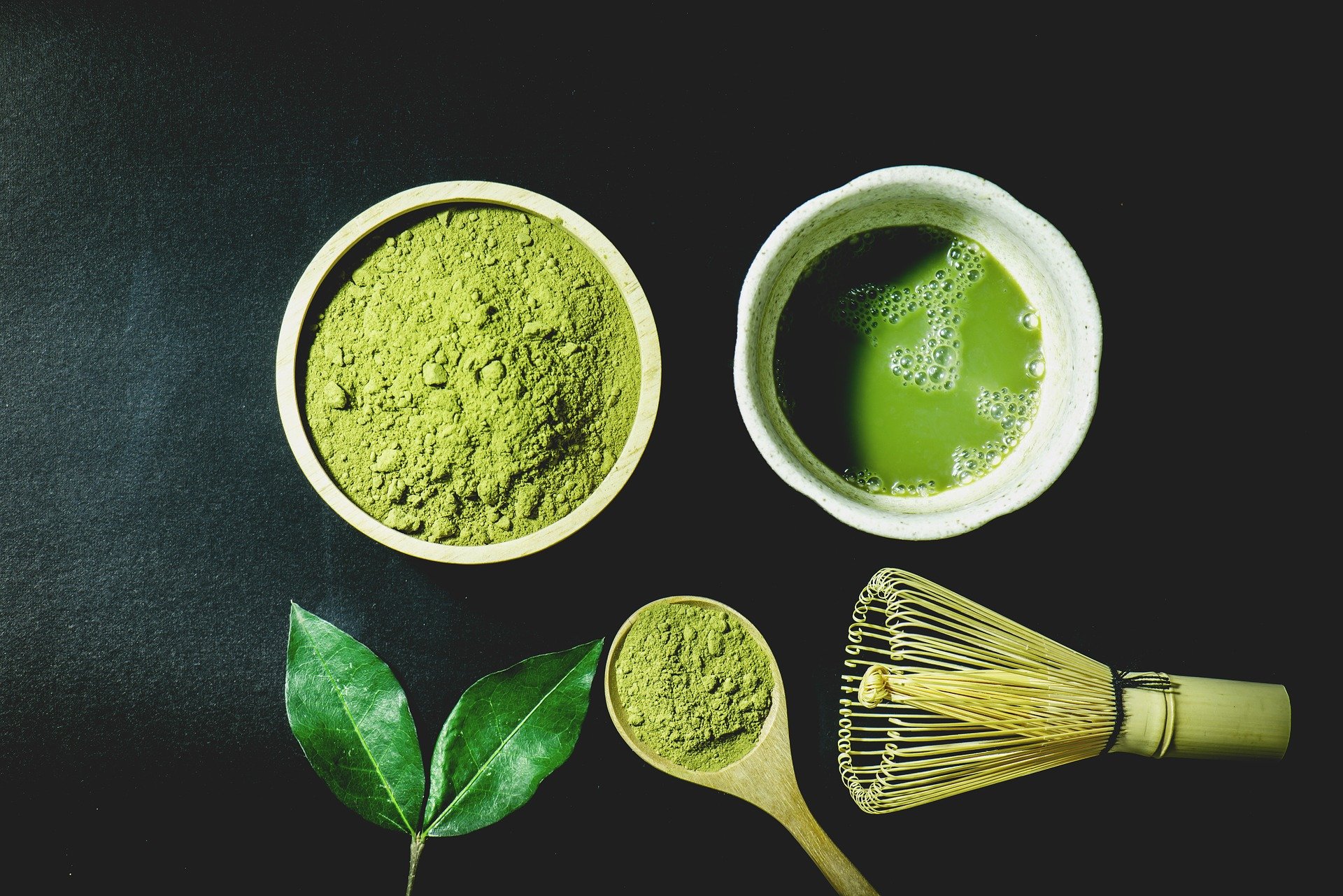Although Matcha also has a word for tea, it is different from traditional loose leaf tea. It is also not simply green tea powder.
The matcha we drink now, by definition, is an ultrafine powder made from the delicate raw materials of tea leaves through multiple processes such as steaming, cooling, dehydrating, compound drying, and combined pulverization.
It is a cup of tea, but you can’t find the fragrance of the leaves; there is a scent of fragrance, but you don’t have to endure the bitterness of the taste. This is matcha, which is as high as green tea and as peaceful as water.
So, what is matcha?
The Japanese Tea Industry Center defines Matcha as follows: Covered with cultivated fresh tea leaves, dried tea leaves without kneading (this process is called tea milling), and a very fine powder made by stone milling.
Generally speaking, Matcha is finely ground powder of specially grown and processed green tea leaves,it is a special form of green tea where premium green tea leaves are stone-ground into a fine powder. traditionally consumed in East Asia especially in Japan. The green tea plants used for matcha are shade-grown for three to four weeks before harvest; the stems and veins are removed during processing. During shaded growth, the plant Camellia sinensis produces more theanine and caffeine. The powdered form of matcha is consumed differently from tea leaves or tea bags, as it is suspended in a liquid, typically water or milk.
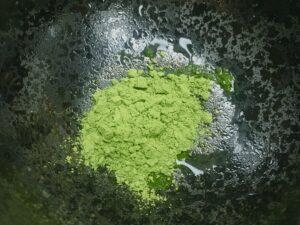
Matcha has high requirements for the quality of raw materials. It requires tea with high amino acid, protein and leaf green content. At the same time, the content of caffeine in the raw materials is low, and the content of tea polyphenols is also relatively low. Because of the different endoplasmic substances, matcha is drinkable. Compared with ordinary green tea, it is more fresh and refreshing, and the bitterness and astringency will be lower, and the palatability will be good.
History of Matcha
Matcha originated in China, rose in the Tang Dynasty(6th-9th century), and flourished in the Song Dynasty(9th-12th century). As early as the Tang Dynasty in 6th century, people invented matcha(milled tea), and also reviewed the method of evaluating the color and fragrance of tea, and it became an indispensable daily drink for people. It can be seen that Matcha has a history of more than a thousand years, even hundreds of years earlier than the current oolong tea ceremony.
However, since the Ming Dynasty(13th century),drinking loose leaf tea become more and more popular,The matcha tea ceremony was lost, and the traditional tea mills production also not commonly used. On the other hand, Matcha and related tea sets was brought back to Japan by Japanese monk Zhaoming Nanpu from China in 11th century, making matcha flourish in Japan. In short, Matcha was invented in China, spread to Japan and flourished in Japan, which is why most consumers think that matcha is made in Japan. However, in recent years, with the rise of matcha in various countries in the world, China’s domestic demand for matcha has also increased. The Jiangnan and Southwest tea regions, the main green tea producing areas in China, have the conditions for matcha production, so there are many companies The green tea plantation has been transformed into a matcha plantation. At present, there are more than 30 tea plantations participating in the production of matcha across the country. After rapid development in recent years, the matcha industry has achieved remarkable results in the market and consumer cultivation, and market demand is increasing day by day. Among them, matcha produced in Zhejiang and Guizhou provinces is the most famous. The quality of high-end matcha is comparable to that of Japanese matcha, and most Chinese Matcha meets EU standards.
Our company’s matcha is mainly produced in Zhejiang, with good quality and competitive price.
How Matcha is produced?
1. The shadow of growth:
The tea leaves are shading treated, and covered with bamboo mats, installed straws or black plastic gauze on the top. All matcha tea is made with shade-grown tea leaves. This is a labor-intensive process that requires protecting the tea trees from sunlight and filtering the light into the tea trees in a very controllable manor. These mulches can protect tea trees from direct sunlight, promote the production of chlorophyll in plants, make the leaves rich in green, and change the natural content of tea polyphenols, caffeine, amino acids and protein. The process starts about 20 days before harvest time. The rich chlorophyll gives the matcha a lush green color, and the high amino acid content also gives the tea a rich and refreshing flavor. Some tea tasters will feel a bit of seaweed flavor. This special planting method is the basis to ensure that the matcha has a green appearance and a fresh taste.
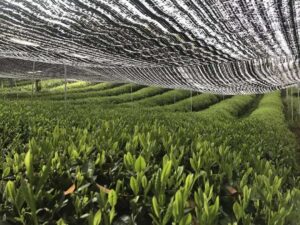
2.Raw Teas Picked:
usually The tea pickers start to pick the youngest and greenest tea leaves for highest quality matcha in April.these tea leaves from the first harvest have the absolute finest quality, compared to the second harvest which occurs 40-45 days after, which mainly produced as middle quality of matcha.
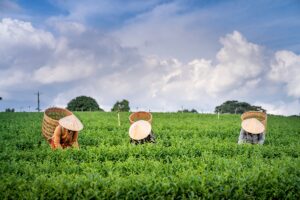
3. Fixation with steamed way to keep fresh green appearance.
This is aims to continue to evaporate the moisture of tea, to damage the enzyme activity in the leaves to prevent the leaves from oxidizing, and to produce fragrance. Furthermore, it enables the leaves to retain its vibrant green color along with the amino acids and other nutritional components.
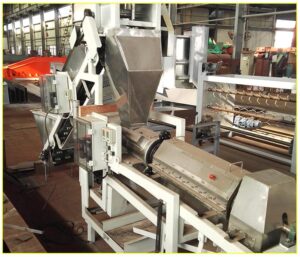
4.Remove stems, impurities and dried again:
Before the tea leaves are stone-ground into rich green match, they are de-stemmed to ensure only the finest leaves are grounded into matcha, then these pure finest leaves are dried again for the next important process step.

5.Grounded into Matcha:
the last step in the matcha production process is the grinding, processorers grounds the tea on stone mills, this is also the key step to achieve a fine, smooth powder texture and superior consistency. it is this process step that matcha literally derived its name from — ground tea.
